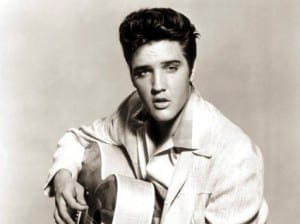Elvis remarked: “The image is one thing and the human being is another.”
The Elvis Presley quote is from: Is Gwyneth Paltrow Wrong About Everything? When Celebrity Culture and Science Clash (2015). I borrowed the book from the Toronto Public Library because evidence is of interest to me:
Evidence has value to the extent it is solid, verifiable, and corroborated by other solid evidence
Eat your vegetables; the research is persuasive
Elvis Presley
In Is Gwyneth Paltrow Wrong About Everything? (2015), Elvis is quoted as saying: “The image is one thing and the human being is another. It’s very hard to live up to an image, put it that way.”
Marilyn Monroe is quoted, in the same chapter, as saying: “Fame doesn’t fulfill you. It warms you a bit, but that warmth is temporary.”
Chapter 11 is entitled: “A lonely, health-destroying grind?” The Elvis and Marilyn quotes appear in this chapter, which in turn is in Part III – entitled: “The illusion that celebrity culture is worth having” – of the book.
I enjoy music by Elvis Presley. Over the years, I’ve often played his music on the sound system of my car.
Celebrity culture

1929 photo: Three-year-old Norma Jean Mortensen (Marilyn Monroe) on the beach as a toddler with her mother Gladys Baker. From mashable.com article, accessed via Twitter on March 1, 2015. Source: http://mashable.com/2015/03/01/marilyn-monroe-child/?utm_cid=mash-com-Tw-main-link
An excerpt (p. 280) from Part III, Chapter 11, of the book by Timothy Caulfield (born in 1963) provides the context for the Elvis quote (I’ve broken the longer texts into shorter paragraphs):
“So maybe being a celebrity is not all it’s cracked up to be. In fact, few actual studies have been performed to test this proposition. One of those, published in 2009, involved in-depth and prolonged interviews with fifteen high-profile celebrities, including individuals from the worlds of acting, music and sports. The authors’ goal was to get a sense of what it is like to be famous. What are the advantages and disadvantages?
“The celebrities were not named, but I can report, after chatting with one of the authors, that they were authentically successful and well known. Naturally, they listed the expected benefits, such as material wealth (which, as noted, is not always sustained), privileged access (again, temporary, unless celebrity status continues) and a feeling of symbolic immortality.
“But the interviewees also disclosed many significant downsides, including loss of privacy, feelings of isolation, the inability to trust others and the need to create a ‘character split’ between the celebrity entity and the private self. This split can cause significant personal challenges. As Elvis Presley observed, ‘The image is one thing and the human being is another. It’s very hard to live up to an image, put it that way.’ ”
Marilyn Monroe
On page 286, some pages after the Elvis quote, an observation from Marilyn Monroe also appears, in the following context:
“A clear materialistic theme emerged: simply put, some people want to be famous to get the tangible benefits of fame. Celebrity status, he reported, is seen as ‘a vehicle for the achievement of a particular lifestyle that satisfies personal goals.’ [John] Gountas subsequently commented that he was motivated to do the work because he believes the increasing desire for fame is ‘not just a blip on our radar, but actually a large social and cultural change among young people.’
“It seems to me that these findings go to the heart of the illusion that achieving fame and celebrity will confer certain benefits and will, ultimately, make us happy, which, we now know, is far from a certain outcome. As Marilyn Monroe once said, ‘Fame doesn’t fulfill you. It warms you a bit, but that warmth is temporary.’ ”
Celebrity authority
Chapter 5, entitled: “Beauty and/or health?”, is in Part I of the book; that part is entitled: “The illusion of celebrity authority.”
The conclusion of Chapter 5 (pp. 184-185) shares the following overview (I’ve broken the longer texts into shorter paragraphs):
“Celebrity culture is such a powerful and pervasive force that it likely has an impact on our perceptions and beliefs even when we don’t recognize it. I have had numerous gluten-free, juicing, cleansed, detoxified friends and acquaintances tell me, without a hint of irony, some version of this: ‘Only an idiot would listen to celebrities.’
“But the influence is subtle and hard to ignore. Celebrity culture leverages our biologically predetermined love affair with beauty, helping to perpetuate an aesthetic angst that can never be resolved, especially by the useless products and advice that flow from the celebrity maw. We should constantly remind ourselves of the existence of these cultural forces and biological predispositions.
“Perhaps say a little mantra: We should not let celebrity lies defy the science-informed six. (Sure, I’m not Jay-Z or Eminem . . . or, even, Vanilla Ice, but it works.) From a health perspective, these six steps are well known and time tested:
1. Don’t smoke.
2. Stay active, exercise regularly and include some vigorous activities.
3. Eat a balanced and calorie-appropriate diet that includes lots of fruits and vegetables, whole grains, lean protein, etc.
4. Maintain a healthy weight (tough, I know).
5. Wear sunscreen.
6. Get an appropriate amount of sleep (which, for most, is between seven and nine hours a night).
“That is it. Everything else is either total baloney or of such marginal value when compared to the impact of these actions as to be nearly irrelevant. For example, if you smoke or don’t exercise, worrying about eating organic food is like Wile E. Coyote using that tiny, broken umbrella to minimize the effects of a house-sized boulder falling on his head.
“Celebrity culture, at best, is selling us a tiny, broken umbrella.”
Update (1)
A Feb. 28, 2015 Globe and Mail article, in which Timothy Caulfield shares observations about a presentation at a university-sponsored conference on non-traditional health care, is entitled: “University of Toronto instructor and speaker boosts ‘alternative vaccines’ “.
The article notes:
“Across Canada, more academic institutions are offering alternative health courses . The problem is that alternatives to evidence-based medicine are not rooted in science, says Timothy Caulfield, Canada Research Chair in health law and policy at the University of Alberta’s School of Public Health. He worries about the consequences of holding events such as U of T’s alternative health conference. ‘It’s problematic when a university, an institution, lends credibility to these kinds of presentations with its name and support,’ he said. ‘Having University of Toronto’s name next to their names on these [promotional] posters legitimizes their position and can be used to legitimize their unscientific views.’ ”
[End of excerpt]
Update (2): re: Big Fat Surprise (2014)
I have added an update to a previous post, concerned with evidence and evidence-based practice; the previous post is entitled:
The update that I’ve added, at the above-mentioned post, reads:
A March 2, 2015 CBC “Point of View” article is entitled: “Don’t be fooled by big fat surprises, fat is still bad for you: Popular diet books can oversimplify the message about fat and calories.”
The article notes:
“The new movement to redeem fat was fuelled by a 2014 study in the Annals of Internal Medicine.
“This review of 32 studies is often cited as proof that saturated fats are good for you.
“However, that is not what the study actually showed, says [Dr. David Katz, director of the Yale University Prevention Research Centre and president of the American College of Lifestyle Medicine.]
“The study found no difference between high-fat and high-sugar diets when it came to cardiovascular disease.
“But that does not mean that saturated fat is good for you, says Katz. ‘Whether it was low-sugar, high-fat or high-sugar, low-fat, the rates of heart disease were basically the same and really high. Everybody lost.’
“You can cut the fat and eat badly, just like you can cut carbs and eat badly.
” ‘There’s a simple shortcut that’s even better,’ Katz says. That’s eating wholesome foods — things like fruits, vegetables, nuts, seeds, lentils and fish — in sensible combinations.”
[End of text of update]
Updates (3)
A March 26, 2015 CBC article is entitled: “Human embryo modifications must be halted, scientists urge: Warning suggests there could be safety and ethical concerns if moratorium isn’t imposed.”
The article notes:
“It’s the risks associated with modifying human sperm and eggs that might have unforeseen consequences, which spurred the ‘uh oh’ moment now, said Timothy Caufield. He holds the Canada Research Chair in health law and policy at the University of Alberta in Edmonton.
” ‘The concern is can we use this technology in an inappropriate way to alter the genome, alter the germ line to alter our human genetic heritage,’ Caufield said.”
A March 29, 2015 Globe and Mail article is entitled: “The vitamin D dilemma: How much should we be taking?”
A July 31, 2015 Toronto Star article is entitled: “U of T Scarborough dean resigns after vaccination flap: The dean of the University of Toronto Scarborough resigned Friday nearly a month after an investigation by the school exonerated an instructor who taught a controversial antivaccine class.”
A Feb. 10, 2016 Guardian article is entitled: “Opinion vs facts: why do celebrities so often get it wrong? Celebrities often make wildly inaccurate claims and comments to millions of people. But the workings of our minds mean we’re all prone to such behaviour.”
A Nov. 29, 2016 CBC article is entitled: Health law expert warns of ‘pseudo-science’ after Alberta child deaths: Tim Caufield says there’s ‘confused messaging’ about natural remedies.”
Also of interest: A Dec. 26, 2017 Guardian article is entitled: “Protein hype: shoppers flushing money down the toilet, say experts: Consumers fuelling demand for high-protein products unlikely to see any benefits as people already eat more protein than they need, say dietitians.”



Oh my goodness Jaan, you float a whole raft of ideas in front of us with numerous items to poke at. I’m willing to nibble at the evidence based medicine subject. My feeling is that the desire to address alternative medicine 1) acknowledges reader interest, and 2) reflects the possibility that there might really be something legitimate beneath the surface that when discovered might make you sound dumb. I do agree however that there is the danger of conferring legitimacy upon something by being willing to set it up on stage next to a well-accepted view. Isn’t that false equivalency or false balance in reporting…whatever the term is. But what I’d inject into the conversation is the technique employed quite often… that is to destroy faith in legitimate study by 1) making claims of contradictory findings without having scientific/sound bases for that, and 2) misrepresenting what the original researchers actually observed and concluded. I think your material points to a case of that happening.
The question of evidence based medicine is of much interest Charles. I agree with the points that you have made, in your comments. I would add that my understanding of the underlying issues is more basic than your own understanding, which appears to have a stronger foundation than my own level of understanding.
A topic that comes to mind, when I think about the nature of evidence, and what the term evidence-based practice entails, concerns two particular ways of looking at Tibetan Buddhism, among all of the possible ways that the topic can be approached. I’ve addressed this topic in a preliminary way in a previous post:
In which Buddhist cultural practices meet ethnographic and neuroscience research
The salient observation, that occurs to me, is that Sherry B. Ortner brings offers much of value in her analysis of Buddhist cultural practices from the vantage point of sociological theory and ethnographic research. The second form of research, also addressed in the previous post, concerns studies that have been conducted within the academic frame of reference of neuroscience. The latter research also addresses Buddhist cultural practices, but from another academic frame of reference, and using tools of analysis that differ from ethnographic field research.
I found the the Scientific American article, referenced in the blog post that I’ve referred to above, of interest.
I have an interest in these topics because I’m a beginner practitioner of mindfulness, having taken an eight-week Mindfulness Based Stress Reduction course a decade ago, and having been meditating regularly every day ever since. That’s a particular reason why the Scientific American article is enjoyable for me to read.
The ethnographic research creates a kind of distancing effect, which is characteristic, for better or worse, of quite a bit of academic research. Neuroscience research, while it can readily give rise to narratives that some observers would describe as not helpful, in this case brings a person a little closer, I would say, to the topic at hand.
With regard to frames of reference, and how approaches to reality influence our perception of it, I also have a strong interest in the contrast between the traditional National Film Board approach to documentary making (starting with prewar and wartime filmmaking) and the approach developed by the Maysles brothers in the United States. I’ve referenced this distinction in a recent update at the following post. Again, it’s a topic that is of interest to me:
Erving Goffman began his graduate work in Chicago in 1945
The update brings attention to the vastly different approaches to documentary filmmaking at the National Film Board as compared to the work of the Maysles brothers. The update notes that an excerpt from Albert Maysles (2009) observes that Albert Maysles focused upon what Erving Goffman’s called “the presentation of self in everyday life.” Albert and David Maysles approached documentary making from a perspective that vastly differed from that of the National Film Board. Albert and David Maysles: Interviews (2010) shares an overview of the work of the Maysles brothers.
A related post, which deals with how Regent Park, a Toronto housing development that has recently been redeveloped, has been represented and portrayed by the NFB in years past, is – along with the above-noted post about Erving Goffman – among the most frequently visited posts at my website according to Google Analytics:
Framing Regent Park: The National Film Board and the construction of “outcast spaces” in the inner city – 1953 & 1994
An April 10, 2017 New York Times article is entitled: “Why Are So Many People Popping Vitamin D?”